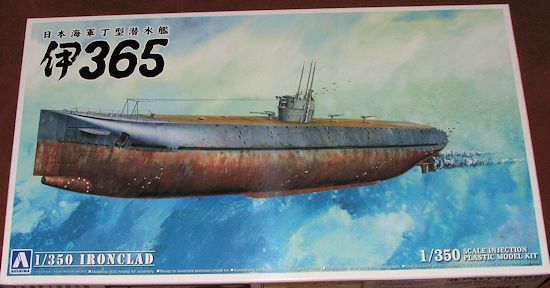
Aoshima 1/350 Submarine I-365
| KIT #: | 005682 |
| PRICE: | 3600 yen SRP |
| DECALS: | One option |
| REVIEWER: | Scott Van Aken |
| NOTES: |

| HISTORY |
The I-361 class submarine (伊三百六十一型潜水艦 I-361-gata Sensuikan) was a type of the 1st class submarine in the Imperial Japanese Navy serving during the Second World War. They are often referred to as Type D submarines.
After the Battle of Midway the IJN immediately planned a transport submarine. The type was based on the U 155 Deutschland. Her duties were transportation of troops (110 men, 10 tons freight and 2 landing crafts) in the areas where the enemy had air superiority. Later the demands for her were changed in sequence. The final demands were 65 tons in the hull and 25 tons on the upper deck (freight only). In the beginning the IJN did not intend to equip these boats with torpedos. Later, after strong demands from the front commanders, it was decided to equip them with torpedoes for self-defense.
Below is the operational history of the I-365.
14 August 1944:
The I-365 is completed at the Yokosuka Navy Yard, commissioned in the IJN and
based in the Yokosuka Naval District. The I-365 is a Type D1 "Tei-gata"
transport submarine and has no torpedo tubes. LtCdr Nakamura Motoo is the
Commanding Officer. The I-365 is assigned to SubRon 11 for working up.
| THE KIT |
 Outside
of perhaps the resin market, this is the first time I've seen a kit of a
transport submarine. Considering how many standard Japanese subs were used as
transports, I guess it is about time we see one kitted. It is an interesting
looking boat with more than the usual number of deck fittings, consisting of
cargo cranes and self defense guns. The small conning tower is a bit unusual
compared to what we are used to seeing on subs.
Outside
of perhaps the resin market, this is the first time I've seen a kit of a
transport submarine. Considering how many standard Japanese subs were used as
transports, I guess it is about time we see one kitted. It is an interesting
looking boat with more than the usual number of deck fittings, consisting of
cargo cranes and self defense guns. The small conning tower is a bit unusual
compared to what we are used to seeing on subs.
In accord with other Aoshima submarines, this one has the main hull split vertically with a separate upper deck piece. There are considerable reinforcing sections to go between the hull halves, making for a sturdy construct. From the look of the conning tower, it seems that this ship is fitted with rudimentary snorkels.
The upper deck is in five different sections, setting on lips surrounding the upper hull halves. Upon this decking fit the conning tower, various guns, cranes and bollards. The dive planes appear to be molded in the extended position (assuming they even retracted). A neat addition to the deck is a pretty good size landing craft, undoubtedly used to move cargo to shore. The kit comes with a nice, broad base and is held to the base via small mounts and attached with screws that are included.
Instructions are well done though mostly in Japanese. colors are in Gunze paint numbers and a color chart is provided. There is no photo etch, though a small note in the back of the instructions shows an aftermarket p.e. and wood deck set. Looking at the parts diagram, you'll see that quite a few of the bits on the B sprue are not used. The small decal sheet (not shown) provides hull number and flags.
| CONCLUSIONS |
Those of us who like to build submarine kits will find this one to be a welcome addition to what has already been done. Japanese boats did not have the success as their German counterparts and perhaps this is why the interest is not as great. One thing for sure, this one will make an interesting comparison on your display shelves.
| REFERENCES |
http://www.combinedfleet.com/I-365.htm
http://en.wikipedia.org/wiki/Type_D_submarine
November 2013 Thanks to
www.dragonmodelsusa.com for the preview kit. Get yours
today at your local retailer or have them order it for you. If you would like your product reviewed fairly and fairly quickly, please
contact
the editor or see other details in the
Note to
Contributors.